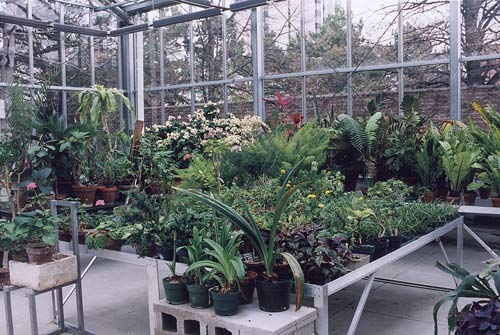Tomatoes
SOW DEC, JAN, FEB, MAR
harvest MAY, JUN, JUL, AUG, SEP, OCT
Tomatoes are the classic greenhouse plant and one of the most popular grow-your-own crops. When grown successfully, they are notoriously heavy croppers, but it is probably the huge range of types available that makes them so seductive. In recent years, supermarkets have begun to pick up on our interest in very small or very large — and above all very tasty — tomatoes, but not before plenty of gardeners had already resorted to growing their own, happily and successfully. Tomatoes are generally considered a reasonable challenge to grow, so that means there are a lot of good gardeners out there!
Cultivation
DIFFICULTY They require plenty of attention, but the rewards are great.
SOW Two seeds to a pot in modules or small pots. Put them in a heated propagator at 16-18°C (60-65°F). Sow in mid- to late winter for growing on in a heated greenhouse (13°C/55°F), delay by about a month for an unheated one. If two seedlings emerge, nip out the weaker one.
PLANT Pot on into larger pots as necessary; don't over-pot, but don't allow the plants to become pot bound either: they need to be able to grow fast and freely. When they have reached about 20-25cm (8-10in), plant them out into the soil borders — spacing them 60cm (2ft) apart — or two to a growing bag or into 30cm (12in) pots.
'Sung°Id' has long trusses of small fruit with a sweet flavor that develops well under cover.
CARE Immediately after planting, give each plant a good watering in, then continue watering, but not over- generously, until the first flowers open. Increase the amount you water as the fruits start to swell. Start feeding with liquid tomato feed as soon as the plants reach about 15cm (6in) tall, or even before. After planting, feed once a week, increasing to twice a week once the first fruit have set. Although tomatoes like warmth, they don't like excessive heat. Ventilate well, especially as temperatures reach 21°C (70°F) or more. Support cordon types on canes, or strings fixed to overhead supports, and pinch out the sideshoots that appear in leaf axils when they are about 2.5cm (1n) long. Bush varieties can be left to get on with it unsupported and without any pinching.
HARVEST Pick tomatoes as soon as they turn fully red; left on the vine they will soften and split. In a heated greenhouse you can look forward to crops from late spring; an unheated one will start ripening fruit in early summer. The fruit will continue to ripen until mid-autumn in a good year. When the plants have to be cleared away, any final green fruits can usually be ripened in a dark place indoors. You can also pull up the entire vine and hang it upside down to ripen.
STORAGE If you have a glut, try roasting them in the oven with olive oil and garlic, then freezing them for using in sauces later in the year. Alternatively, make chutneys and relishes.
You can visit this flower guide for more information about this article.



